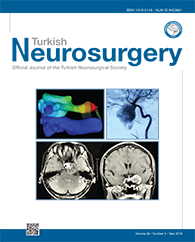2Shahid Beheshti University of Medical Sciences, Shohada Tajrish Hospital, Department of Stereotactic Neurosurgery, Tehran, Iran
3Harvard Medical School, Massachusetts General Hospital, Neurovascular Research Laboratory, Department of Radiology, Massachusetts, USA DOI : 10.5137/1019-5149.JTN.11759-14.1 AIM: Pineal tumors represent uncommon intracranial tumors with highly diverse histologic subtypes. There still exists a controversy in literature about what influences overall survival and outcome.
MATERIAL and METHODS: We present the results of 48 patients with pineal tumor treated either by stereotactic biopsy followed by adjuvant therapy (23 patients) or open surgical resection without (18 patients) or with (7 patients) adjuvant therapy in Shohada Tajrish Hospital, Iran (1993-2008).
RESULTS: Unremarkable pathology yield was 3/23 in the biopsy and 1/25 in the surgical group. Perioperative mortality and morbidity were 4.3% and 0% in the biopsy group and 32.0% and 4.0% in the surgical group. Analysis showed that age, gender, cranial nerve deficit, motor deficit, preoperative Karnofsky Performance Score (KPS), midbrain involvement, and brain stem involvement had no effect on neither perioperative mortality nor long-term survival, while local invasion and pineocytoma pathology increased perioperative mortality and presence of hydrocephalus and pineoblastoma pathology significantly decreased long-term survival. Hospitalization length was shorter in the stereotactic biopsy plus adjuvant therapy group.
CONCLUSION: The results of the study suggests that although gross total resection is the standard of care in most pineal tumors nowadays, stereotactic biopsy followed by adjuvant therapy may still be a safe and viable option.
Keywords : Pineal tumor, Stereotactic, Biopsy, Resection, Adjuvant therapy




